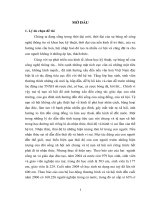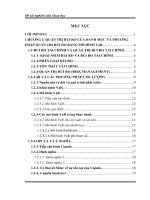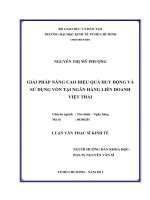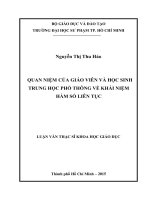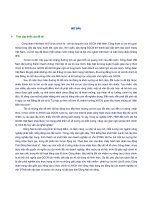(Luận văn thạc sĩ) nhận thức của giáo viên trung học phổ thông về việc sử dụng dạy học dự án trong sách giáo khoa tiếng anh thí điểm
Bạn đang xem bản rút gọn của tài liệu. Xem và tải ngay bản đầy đủ của tài liệu tại đây (964.99 KB, 71 trang )
VIETNAM NATIONAL UNIVERSITY, HA NOI
UNIVERSITY OF LANGUAGES AND INTERNATIONAL STUDIES
FACULTY OF POST-GRADUATE STUDIES
*********************
HOÀNG THỊ HÀ XUYÊN
HIGH SCHOOL TEACHERS’ PERCEPTIONS OF PROJECT-BASED
LEARNING IN THE NEW ENGLISH TEXTBOOKS
(Nhận thức của giáo viên trung học phổ thông về việc sử dụng phương pháp
học dự án trong sách giáo khoa tiếng Anh thí điểm)
M.A. MINOR PROGRAMME THESIS
Field: English Teaching Methodology
Code: 60140111
HANOI – 2017
VIETNAM NATIONAL UNIVERSITY, HA NOI
UNIVERSITY OF LANGUAGES AND INTERNATIONAL STUDIES
FACULTY OF POST-GRADUATE STUDIES
**********************
HOÀNG THỊ HÀ XUYÊN
HIGH SCHOOL TEACHERS’ PERCEPTIONS OF PROJECT-BASED
LEARNING IN THE NEW ENGLISH TEXTBOOKS
(Nhận thức của giáo viên trung học phổ thông về việc sử dụng phương pháp
học dự án trong sách giáo khoa tiếng Anh thí điểm)
M.A. MINOR PROGRAMME THESIS
Field: English Teaching Methodology
Code: 60140111
Supervisor: Dr.Vũ Thị Thanh Nhã
HANOI - 2017
DECLARATION
I hereby certify the thesis entitled “High school teachers‟ perceptions of
project-based learning in the new English textbooks” as my own work in the
fulfillment of the requirements for the Degree of Master of Arts at the University of
Languages and International Studies, Vietnam National University, Hanoi.
Hanoi, 2017
Hoàng Thị Hà Xuyên
I
ACKNOWLEDGEMENT
This thesis would not be completed without the help of a number of people. From
my deep heart, I would like to express my thanks to all of them.
First of all, I would like to express my deep sense of gratitude to my beloved
supervisor, Dr. Vu Thi Thanh Nha, for her enthusiastic and careful guidance as well
as her encouragements she gave me while I was doing this study.
Second of all, I would like to take this opportunity to express my sincere
thanks to my respectful lectures in Faculty of Post-Graduated Department at
University of Languages and International Studies for their devotion and their
useful lectures.
Last but not least, I would like to give my great thanks to my friends and all
teachers for their willingness to take part in my research.
II
ABSTRACT
This study explored high school teachers‘ perceptions of project-based learning
in the new English textbooks. The specific areas of investigations were teachers‘
perceptions about (1) PBL‘s definitions, PBL‘s benefits for students in language
learning in terms of motivation, improvements in language skills, learning
autonomy, teamwork skills and teachers‘ roles in PBL, (2) their challenges in
implementing PBL. The findings from questionnaires and interviews reveal that
teachers had a clear understanding of PBL was and a positive attitude to the benefits
of PBL for students in language learning. Also, the results of the study show that
teachers encountered with three main challenges when implementing PBL :
students‘ ability, time for preparation and schools‘ facilities. Basing on these
findings, suggestions are made to enhance the success of PBL in teaching and
learning English language.
III
TABLE OF CONTENTS
Declaration .................................................................................................................. I
Acknowledgement......................................................................................................II
Abstract .................................................................................................................... III
Table of contents ...................................................................................................... IV
List of abbriviations ................................................................................................. VI
List of figures and tables .........................................................................................VII
PART A
INTRODUCTION ..................................................................................................... 8
1.Rationale for the study ..........................................................................................8
2.Aims of the study ..................................................................................................9
3.Research questions ................................................................................................9
4.Scope of the study .................................................................................................9
5.Method of the study ..............................................................................................9
6. Design of the study ..............................................................................................9
PART B
CHAPTER I: LITERATURE REVIEW .............................................................. 11
1.1.Teacher cognition ...........................................................................................11
1.1.1.Definition of teacher cognition ...............................................................11
1.1.2.The importance of teacher cognition ........................................................12
1.1.3.The relationships between teacher beliefs and classroom practice. .........12
1.2.Project-based learning .....................................................................................13
1.2.1.Definitions of project-based learning .......................................................13
1.2.2. Characteristics of project-based learning................................................14
1.2.3.Benefits of project-based learning ............................................................15
1.2.4.Challenges of project-based learning .......................................................17
1.2.5. Teachers’ roles in project-based learning ...............................................18
1.3.The previous studies of project-based learning in English language teaching 19
1.4. An overview of the new English textbooks ....................................................21
CHAPTER II: METHODOLOGY........................................................................ 29
IV
2.1.Context of the study .......................................................................................29
2.2. Research questions ..........................................................................................29
2.3.The study..........................................................................................................30
2.3.1. Participants .............................................................................................30
2.3.2. Data collection instruments ...................................................................30
2.3.3.Data collection procedure .........................................................................32
CHAPTER III: FINDINGS.................................................................................... 34
3.1.The findings from questionnaires ....................................................................34
3.1.1.Teachers’ background information ...........................................................34
3.1.2. Teachers’ perceptions of PBL and their challenges in implementing PBL
............................................................................................................................35
3.2. The findings from interviews..........................................................................44
3.2.1.Teachers’ perception of project-based learning in the new English
textbooks .............................................................................................................44
3.2.2 Teachers’ challenges .................................................................................48
PART C
CONCLUSION ........................................................................................................ 51
1.Summary of the key findings ..............................................................................51
2. Implications .......................................................................................................53
3. Limitations of the study .....................................................................................54
4. Suggestions for further study .........................................................................55
REFERENCES ........................................................................................................ 56
APPENDENCES ....................................................................................................... I
APPENDIX 1 ......................................................................................................... I
APPENDIX 2 .......................................................................................................... V
APPENDIX 3 ........................................................................................................ VI
APPENDIX 4: .................................................................................................... VII
APPENDIX 5:......................................................................................................... X
APPENDIX 6:....................................................................................................... XI
V
LIST OF ABBRIVIATIONS
ELT: English Language Teaching
MOET: The Ministry of Education and Training
PBL: Project-based learning
SPSS: Statistical Package for the Social Sciences
VI
LIST OF FIGURES AND TABLES
Figure 1: Teachers‘ teaching experience .................................................................. 34
Figure 2: Teachers‘ time of knowing project-based learning ................................... 35
Table 1: The performance objectives of the new textbooks ..................................... 23
Table 2: Topics in English 10, English 11 and English 12 ....................................... 28
Table 3: Teachers‘ definition of PBL ....................................................................... 37
Table 4: The benefits of PBL for students‘ motivation in English learning ............. 38
Table 5: The benefits of PBL for students‘ improvements in language skills .......... 39
Table 6: The benefits of PBL for students‘ learning autonomy................................ 40
Table 7: The benefits of PBL for students group work............................................. 40
Table 8: Teachers‘ roles in implementing PBL ........................................................ 41
Table 9: Teachers‘ challenges in implementing PBL ............................................... 42
VII
PART A
INTRODUCTION
1. Rationale for the study
Recently, the Ministry of Education and Training (MOET) has paid more
attention to teaching and learning foreign languages. In secondary education,
Decision No 5209/QD –BGDĐT was released on the 23rd of November, 2012 on
the Approval of Chương trình giáo dục phổ thơng mơn tiếng Anh thí điểm cấp trung
học phổ thông (Pilot English Curriculum for Vietnamese Upper Secondary
Schools). Therefore, the new English textbooks namely Tiếng Anh 10, Tiếng Anh
11 and Tiếng Anh 12 are designed and promulgated by MOET. The goals of the
new textbooks are to help students develop their language ability and the
communicative competence through four skills (listening, speaking, reading and
writing). The contents and structures of the new textbooks are different from the old
ones focusing on task-based approach. ―Looking back and Project‖ is one section at
the end of each learning unit, which is new to both teachers and students. A project
lesson focuses on a group activity, which requires students to closely cooperate with
their friends in their own group to make a final product relating to the topic of each
learning unit. The results of project are presented in many different forms such as an
article, a presentation or a PowerPoint. The teacher acts as a guide for students, not
a one-way knowledge transfer as before. Therefore, in order to see whether
applying project is effective in the classroom or not, it is necessary to explore
teachers‘ perceptions of project-based learning because their beliefs may have an
influence on their classroom practice in the future. Here, teachers‘ perceptions
include their attitude, knowledge, evaluation and thinking of project-based learning
(Borg 2006). In fact, many studies about project-based learning have been
conducted; however, studies on teachers‘ perceptions of project-based learning in
second language teaching are very limited. That is motivation for the researcher to
investigate high school teachers‘ perceptions of project-based learning in terms of
its definition, benefits, teachers‘ roles and their challenges in implementing.
8
2.Aims of the study
This study aims at investigating high school teachers‘ perceptions of using
project-based learning in the new English textbooks. The findings of the study will
give suggestions for teachers‘ choice of teaching approaches used in their own
classrooms. Thus, it enhances English language teaching and learning and teachers‘
challenges will be addressed.
3.Research questions
In order to achieve these aims, two research questions are:
1. What are high school teachers‘ perceptions of project-based learning in the
new English textbooks?
2. What are teachers‘ challenges in implementing project-based learning?
4.Scope of the study
Project-based learning in the field of second language teaching is a large
topic. However, this is just a minor thesis so the topic is narrowed in order to
facilitate the research. Also, the researcher is concerned with teachers‘ perceptions
towards the benefits of project-based learning, their roles in the classroom as well as
their challenges they face with during the implementation. The participants of study
include 30 teachers from nine high schools. Thus, the results of study might not be
generalized to all teachers who are piloting the new English textbooks in Vietnam.
5. Method of the study
The study was conducted in the form of mixed research method. In order to
accomplish the study, questionnaires and interviews were employed to collect data
on teachers‘ perceptions of PBL associated to the benefits and the challenges of
PBL in the new textbooks.
6. Design of the study
The study is divided into three main parts as follow:
Part A: Introduction covers the rationale for study, aims, research questions, the
scope, and the design of the study.
9
Part B: Development is organized around three chapters as follows:
Chapter I- Literature review synthesizes the theoretical framework of the study
related to teachers‘ general perceptions, project-based learning and an overview of
the new English textbooks.
Chapter II - Methodology, presents the context, the methodology used in this study
including the subject, the data collection instruments, data collection procedure, and
data analysis
Chapter III – Findings consists of a comprehensive analysis of the data
Part C: Conclusion, offers a summary of the findings, recommendations,
limitations, and future directions for further study.
10
PART B
CHAPTER I: LITERATURE REVIEW
This chapter reviews the theoretical issues related to the topic of the study.
This part will discuss about teachers‘ perceptions, project-based learning in
terms of its definitions, features, benefits, teachers‘ roles and challenges in
implementing PBL and an overview of the new upper-secondary English
textbooks.
1.1. Teacher perception/cognition
This section reviews the relevant literature in the area of teacher
perception for the present study. Drawing on the existing literature, an
operational definition of teachers‘ cognitions offered, providing the author with
the clear understanding of teacher cognition, which is the foundation of the
study. This is followed by an analysis of the importance of teacher cognitions in
research.
1.1.1. Definition of teacher perception
Teacher knowledge, teacher belief or teacher perception/ cognition are not
easy to define, operationalize and study. There have recently been various
conceptualizations defining different sub-areas under the term ‗teacher
cognition‘. Borg (2003:81) states that teacher cognition is ―the unobservable
cognitive dimension of teaching – what teachers know, believe, and think.‖ This
definition with respect to language teacher cognition, according to Borg (2006),
comprises beliefs, knowledge, theories, attitudes, assumptions, conceptions,
principals, thinking, and decision-making, about teaching, teachers, learners,
learning, subject matter, curricula, materials, activities, self, colleagues,
assessments, and context. Such definition unavoidably conveys that ―language
teachers have cognitions about all aspects of their work and that this can be
described using various psychological constructs which I collectively refer to as
teacher cognition‖ (Borg 2006: 283). It is noted that these definitions of teacher
cognition orient the researcher toward data collection, analysis and interpretation
11
during the process of study. Next, the importance of teacher cognition in
research will be discussed to explain why this paper want to explore it.
1.1.2. The importance of teacher perception
There are a number of reasons for teacher beliefs to be of considerable
importance in research. First, it is likely that teacher cognition exerts a powerful
long-term influence on teachers‘ instructional practices (Borg 2011; Burn 1992;
Freeman 1992; Johnson 1992, 1994; Kagan 1992; Pajares 1992; Richards 1998,
cited in Phipps, 2009, p.13). Beliefs greatly influence teachers‘ planning and
instructional decisions. Second, these beliefs seem to be very deep-rooted and may
continue to influence teachers throughout their occupational lives (Borg, 2003).
Third, beliefs are resistant to change and filter what teachers learn from teacher
education. Like other learners, teachers tend to ―interpret new content through their
existing understanding and modify and interpret new ideas on the basis of what they
already know or believe‖ (Kennedy 1991:2). Thus, beliefs influence on the way
teachers assimilate and accommodate knowledge about teaching and learning (cited
in Phipps, 2009, p.13).
Therefore, understanding teacher cognition is important to our understanding
of teaching and the way teachers act. Now, I will discuss the relationships between
teacher beliefs and classroom practice in the following subsections.
1.1.3.The relationships between teacher beliefs and classroom practice.
There are many studies showing the relationships between teacher beliefs
and their classroom practices. Richards (1998) states ―A primary source of teachers‘
classroom practices is belief systems—the information, attitudes, values,
expectations, theories, and assumptions about teaching and learning that teachers
build up over time and bring with them to the classroom‖ (p. 66). Johnson (1992,
cited in Vilbulphol, 2004, p.39) concludes that there was a relationship between
teachers‘ theoretical beliefs and their classroom practices. From her examination on
this relationship and the observation data, she found that the majority of defined
theoretical beliefs are classified into three groups. They include skill-based
12
(emphasizing the practice of discrete skills, attending to the accuracy of language
production, and promoting memorization), rule-based (focusing on the learning of
grammar rules and the practice of structures in meaningful contexts) , and functionbased (promoting the use of authentic materials, communication-oriented activities,
and the appropriate use of language in real situations) approaches, which reflect
their preferred teaching approach. Most teachers favored the function-based
approaches. The researcher also reveals that teacher‘s reading and writing activities
were designed in accordance with their beliefs.
In conclusion, these studies suggest that second and foreign language
teachers possess certain beliefs about second language learning and teaching which
may influence their instructional practices. Therefore, a study on teacher cognition
will give us insights on how to support teachers in implementing project-based
learning. The main second content of this chapter is concerned with project-based
learning, the key focus of the current study.
1.2. Project-based learning
The focus of the study is project-based learning; therefore, this section
explores the aspects of project-based learning including its definitions, features,
benefits, challenges and teachers‘ roles in it.
1.2.1. Definitions of project-based learning
Various authors have proposed many definitions of project-based learning.
Hedge (1993: 276) defines a project as ―an extended task, which usually integrates
language skills work through a number of activities. These activities combine in
working towards an agreed goal and may include planning, the gathering of
information through reading, listening, interviewing, discussion of the information,
problem solving, and oral or written reporting, and display‖.
Thomas (2000) states that PBL is a model that organizes learning around
projects. He also summarizes many different definition of PBL from other studies.
Particularly, the definitions found in PBL handbooks for teachers, projects are
complex tasks, based on challenging questions or problems, that involve students in
13
design, problem-solving, decision making, or investigative activities; give students
the opportunity to work relatively autonomously over extended periods of time; and
culminate in realistic products or presentations (Jones, Rasmussen, & Moffitt, 1997;
Thomas, Mergendoller, & Michaelson, 1999, cited in Thomas 2000, p.1).
Demirhan (2002, cited in Baysura & Yucel, 2015, p.17), PBL is defined and
described as an approach that (1) requires interdisciplinary study, (2) makes
students take responsibility in a group or individually and study collaboratively on
real-life problems based on a specific topic and their personal interests and skills,
(3) gives teachers the roles of facilitating learning and guiding students, (4) results
in students‘ authentic products or presentations, and (5) integrates different
approaches within the self. PBL is a learning and teaching approach through which
students gain new knowledge and skills while researching complex and realistic
problems, designing and planning their own studies and performances, and
producing authentic products. In particular, the PBL approach contributes to their
subject-matter knowledge, problem-solving skills, and self-directed learning.
In summary, there has not been a universal definition of project-based
learning. To better understand what project-based learning is, it is necessary to look
at the characteristics of PBL in the following section.
1.2.2. Characteristics of project-based learning
Many different researchers show characteristics of project-based learning.
Stoller‘s (2007: 4-5) identifies six main features of Project-Based Learning as
follows:
First, ―Project work focuses on content learning rather than on specific
language targets. Real-word subject matter and topic of interest to students can
become central to projects.”
Second, “Project work is student-centered, though the teacher plays a major
role in offering support and guidance throughout the process.”
14
Third, “Project work is cooperative rather than competitive. Students can
work on their own in small groups or as a class to complete a project, sharing
resources, ideas and expertise along the way.”
Fourth, “Project work leads to the authentic integration of skills and
processing of information from various sources, mirroring real-life tasks.”
Fifth, “Project work culminates in an end product (e.g., an oral
presentation, a poster session, a bulletin board display, a report, or a stage
performance) that can be shared with others, giving the project a real purpose. The
value of the project, however, lies not just in the final product but in the process of
working towards the end point. Thus, project work has both a process and product
orientation, and provides students with opportunities to focus on fluency and
accuracy at different project-work stages.”
Sixth, “Project work is potentially motivating, stimulating, empowering, and
challenging. It usually results in building student confidence, self-esteem, and
autonomy as well as improving students’ language skills, content learning and
cognitive abilities.”
With its distinctive features, PBL has drawn a lot of attention from
researchers. The current study focuses both on benefits and challenges of PBL.
Therefore, these issues will be discussed in the two following subsection.
1.2.3.Benefits of project-based learning
Project-based learning offers a wide range of benefits to both students and
teachers. In terms of students, numerous benefits of project work have been cited in
the relevant literature. Researchers of this domain assert the great contributions of
project work to language learning, motivation, stimulation, self-esteem and
autonomy and social aspects.
Haines (1989, cited in Gallacher 2004, p.1-3) summarizes some advantages
of project-based learning consisting of (1) motivation-learners are increased; (2) all
four skills are integrated; (3) Autonomous learning is promoted as learners become
more responsible for their learning; (4) there are learning outcomes-learners have an
15
end product; (5) authentic tasks are given to learners; (6) interpersonal relations are
developed through working as a group; (7) content and methodology can be decided
between the learners and the teacher and within the group themselves so it is more
learner-centered; (8) learners can get help from parents for the project work thus
involving the parents more in the child‘s learning; (9) a break from routine and the
chance to do something different; (10) a context is established which balances the
need for fluency and accuracy.
According to Fried-Booth (2002), project-based learning is a shift from
teacher-centeredness to learner-centeredness, which enhances learner autonomy,
with the characteristics of allowing students to select the topics they are interested
in, providing opportunities to take on leadership roles, and giving them
responsibility for their own learning. In addition, project work gives students a
chance to discuss features of the project such as the theme, product, and procedures
to accomplish the product, and individuals‘ roles and responsibilities in the group.
Project-based learning contrasts with traditional teacher-centered classroom
education; with its democratic learning characteristics, students are free to make
educational decisions in the classroom. By choosing, organizing, and carrying out a
project of their own choice, students take responsibility for their own learning.
These characteristics of project work make students more autonomous and
independent in the face of traditional ways of teaching. Besides, Fried-Booth (2002)
notes that how much a student benefits from project work depends on how much the
student is involved in the exercise. For project-based instruction to help students
promote communication and collaboration with community members, they need to
carry out outside classroom activities. Therefore, project work is a means to develop
students‘ social skills. Hedge (2000) shows that project work fosters students‘
imagination and creativity, self-discipline, responsibility, collaboration, research
skills and cross-curricular work through utilizing information learned in other
subjects.
16
In terms of teachers, project-based learning helps them enhance
professionalism and collaboration among colleagues, opportunities to build
relationship with students. Moreover, many teachers can help to diverse students
realize that the traditional instructional methods and approaches in the classroom
are not effective and then introduce them a wide range of learning opportunities in
their classroom. (Thomas, 2000)
1.2.4. Challenges of project-based learning
Apart from the existing benefits of project-based learning, it brings students
and teachers some unexpected difficulties during the process of implementation.
Particularly, Westwood (2008: 34-35) shows that students may face with the
following challenges.
1. Students lack necessary skills for researching and collecting information
2. Students’ learning and contributing to give the impression of productive
project work may be very little.
3. Due to a weak understanding of the topic of projects, the production of
posters, models, charts, recordings, photographs and written report on
display is challenging for students.
4. Individual members of different groups do not have a general understanding
of the whole topic given by their teacher.
Hutchinson (1992) mentions mixed ability class as a problem in PBL. He
argues that in traditional lessons very often the brighter students "steal" the
teacher´s attention and time for themselves because they are self-confident, more
active and faster in answering teacher´s questions. In project work these students
can work independently, occasionally asking the teacher to supervise or help;
meanwhile the teacher can devote his time to those who need it most, to slower or
less confident students.
Marx et al. (1997) also describes the difficulties encountered by teachers
such as times for preparation, classroom management, subject depth and evaluating
students‘ knowledge after doing project. Eyring (1997) warns teachers that if the
17
main curriculum is based on project work, excessive absence and tardiness,
excessive quietness in some students, the gap between the needs and demands of the
extremely high and extremely low-level students, lack of cooperation among
students, and lack of initiative. Some students may be lazy and do not want to do
anything in a group, which may demotivate the enthusiastic students. The problems
mentioned above affect the success of a project-based classroom because students
may depend too much on the teacher or themselves, rather than on each other, in the
case of such pitfalls. Teachers‘ roles will be mentioned in the next section.
1.2.5. Teachers‟ roles in project-based learning
Haines (1989, cited in Gallacher, p. 5) outlines teachers‘ stage-by-stage role
in project-based learning implementation. In the first step, the teacher should
stimulate students‘ interest and then elicit their ideas for or the thematic direction,
working method, timetable, and suitable final product and resource implications.
The teacher should play a role as a facilitator providing a source of ideas and advice
for students or a referee helping to resolve problems, a chairperson during group‘s
reports to the whole class. Finally, the teacher takes a role of organizer or evaluator
to give efficient organization of displays and productions.
Project-based learning is only possible in classrooms where teachers support
students by giving sufficient guidance and feedback. The teacher must thoroughly
explain all tasks that are to be completed, provide detailed directions for how to
develop the project, and circulate within the classroom in order to answer questions
and encourage student motivation. In order to create successful units focused on
project-based learning, teachers must plan well and be flexible. In this approach to
instruction, teachers often find themselves in the role of learner and peer with the
students. Teachers can assess project-based learning with a combination of
objective tests, checklists, and rubrics; however, these often only measure task
completion. The inclusion of a reflective writing component provides for selfevaluation of student learning. (Bie, 2003)
18
In brief, the aspects of project-based learning are discussed in the second
section of chapter two. The final section will look specifically at the previous
studies on PBL in language teaching, the focus of the present study.
1.3.The previous studies of project-based learning in English language teaching
The purpose of this part is to review literature relating to applying projectbased learning strategy in teaching and learning English as a foreign language and
its impacts on developing language learners' achievement and teachers‘ perceptions
of PBL.
Students‟ achievement in second language learning
Regarding language learners‘ achievement, Gardner (1995) implemented a
video documentary project at the University of Hong Kong that was intended to
allow students to exercise their academic listening comprehension and note-taking
skills. The results were generally positive in that students improved not only their
listening and note-taking skills, but also their writing skills. Similarly, Wanchid and
Wattanasin (2015) did video project at King Mongkut‘s University of Technology
North Bangkok. The findings shows that the students had highly positive attitudes
toward project work in the English course as it offers considerable benefits to the
students especially in terms of teamwork and learning autonomy. The benefits also
stated by the students were that the video project was useful, allowed them to use
their creativity, involved the use of technology, enabled them to work with friends,
and encouraged them to use and practice English more.
Hilton-Jones (1988) discussed a six-week project-based learning English
language course in the U.K., which had a group of West German teenagers
practicing listening, speaking, reading and writing skills in English. The results
showed that they were able to improve their language learning needs with a project.
In Wilhelm‘s (1999) study, most of the students felt great satisfaction in the
opportunity to negotiate meaning with native speakers and to take the responsibility
for their own learning. They indicated that the only pitfall of project work is its
stressful character due to the heavy workload. In this study, projects classes were
19
categorized in accordance with the students‘ TOEFL scores. In addition, all the
students in project classes were given instruction in areas such as trust development
and interpersonal relationships, demonstration of the student and teacher roles, a
model for the collaborative learning approach, giving peer feedback and
negotiation, and a well-balanced grading system.
Teachers‟ perceptions of PBL in second language teaching
Although the research on language teacher cognition has now become a wellestablished domain of inquiry (Borg, 2003, 2006) literature on teachers‘ beliefs
regarding project-based learning implementation is still very limited. Beckett (1999)
showed the scarcity of studies on both project-based learning and teacher and
student perceptions of project work. She indicated that the two ESL teachers
participating in project work in her study, which was carried out in a Canadian
secondary school. She also mentioned that teachers were impressed by the creative
studies of their students and evaluated project-based instruction favorably since it
allowed them to integrate language, content and skills in a communicative way and
to promote critical thinking, problem solving and cooperative learning skills. They
were also satisfied with the result that the students were able to discover their
strengths and weaknesses as learners.
In contrast to the positive attitudes in the studies above, Eyring (1997) shows
the relatively negative results. There was one teacher coordinating PBL in an ESL
university context in the U.S. In spite of being impressed by the final product, she
had many complaints about the process of project. She stated that it was very
demanding to negotiate the curriculum with the students and get them involved in
project at all level because of their lukewarm responses in general. Though the
teacher believed that she tried her best to guide project work for students, they did
not understand and accept input offered in a relatively democratic way. Besides,
they showed much less respect to her compared to her previous students. She
suggested that it would be better to revert to a more teacher-directed approach
20
including traditional ESL activities focusing on reading, vocabulary and grammar to
provide students with something concrete that they can say they have learnt.
Harris (2014) examined middle school teachers‘ perceptions associated with
the implementation of project-based learning. He explored the challenges teachers
faced with when implementing project-based learning, the ways they responded to
these challenges and how they perceived PBL in the 21st Century skills. The study
was conducted at a suburban middle school outside Pittsburgh, PA with forty-nine
teachers‘ participations. Questionnaires was employed to collect data. The findings
showed that teachers perceived that time, meeting state accountability requirements,
addressing the standards, implementing the project within the school‘s schedule and
designing a lesson plan were most challenging when implementing project-based
learning. The study also found that teachers either knew how to respond to
challenges or expressed further concern about doing so. Regarding the 21st Century
skills, teachers perceived that project-based learning addressed more effectively
than traditional methods. Students gained many skills in PBL including
communication, collaboration, creativity, innovation, critical thinking and problem
solving. The next section will give an overview of the new English textbooks.
1.4. An overview of the new English textbooks
This section will provide a brief overview of the new English textbooks
namely Tiếng Anh 10, Tiếng Anh 11 and Tiếng Anh 12 which are being piloted in
nine selected high schools in Vietnam.
In implementing the Vietnamese Prime Minister‘s Decision, on the 23rd of
November, 2012, the Minister of Education and Training signed Decision No
5209/QD –BGDĐT on the Approval of Chương trình giáo dục phổ thơng mơn tiếng
Anh thí điểm cấp trung học phổ thơng (Pilot English Curriculum for Vietnamese
Upper Secondary Schools).
Methodologically, the new English textbooks are
claimed to adopt the communicative approach to language teaching in order to help
students use language (vocabulary, pronunciation and grammar) to develop the
21
communicative competence through four skills ( listening, speaking, reading and
writing). (MOET, 2012)
The specific objectives of the new textbooks are that after graduating from
high school, students “Can understand the main points of clear standard input on
familiar matters regularly encountered in work, school, leisure, etc. Can deal with
most situations likely to arise whilst travelling in an area where the language is
spoken. Can produce simple, connected text on topics which are familiar or of
personal interest. Can describe experiences and events, dreams and hopes and
ambitions and briefly give reasons and explanations for opinions and plans.” (Van
2016: 14). In order to accomplish those objectives, the specific objectives of the
textbooks are classified into the performance objectives through four skills:
listening, speaking, reading and writing (Grade 10: level 3.1; Grade 11: level 3.2;
Grade 12: level 3.3) (see Table 1 below).
Table 1: The performance objectives of the new textbooks
Skills
Grade 10
Grade 11
Grade 12
Listening - Text length between - Text length between 200 - 220 words.
-Follow
220 - 240 words.
Text
length
between 240 - 260
clearly -Generally follow the words.
articulated speech in main
points
of -
Understand
the
everyday conversation, extended
discussion, main points of clear
though
speech
students provided
is standard speech on
sometimes have to ask clearly articulated in a familiar
for
repetition
of standard dialect.
matters
regularly
particular words and -Understand the main encountered
phrases.
points of selected radio school, leisure and
-Understand the main news
bulletins
points in selected TV simple
and daily activities.
recorded -Understand
programs on familiar material on topics of main
topics
in
when
the personal
22
point
interest appropriate
the
of
radio,
delivery is slow and delivered slowly and TV
clear.
clearly.
-Understand
as
or
podcasts on current
simple -Listen
to
technical information, narrative
such
programs
a
short affairs or topics of
and
form personal
interest
operating hypotheses about what when the delivery is
instructions
for will happen next.
everyday equipment.
relatively slow and
clear.
- Listen to a simple
narrative and form
hypotheses
what
about
will
happen
next.
Speaking - Start, maintain and -Start, maintain and -Deal
with
most
close simple face-to- close a conversation or situations likely to
face conversations on discussion on a wide arise
when
topics that are familiar range of topics which interacting
or of personal interest.
are
familiar
or
with
of English-speaking
-Express and respond personal interest, but visitors.
Enter
to feelings such as may sometimes have unprepared
surprise,
happiness, difficulties in trying to conversations
sadness, interest and say exactly what they topics
indifference.
-Agree,
politely
advice.
into
would like to.
disagree -Ask
and
for
and
give detailed directions.
that
on
are
familiar, of personal
give interest or relevant to
everyday life (e.g.
-Give or seek personal family,
views and opinions in travel,
hobbies,
sport
and
an informal discussion current events)
with friends.
-Describe
experiences
23
and

